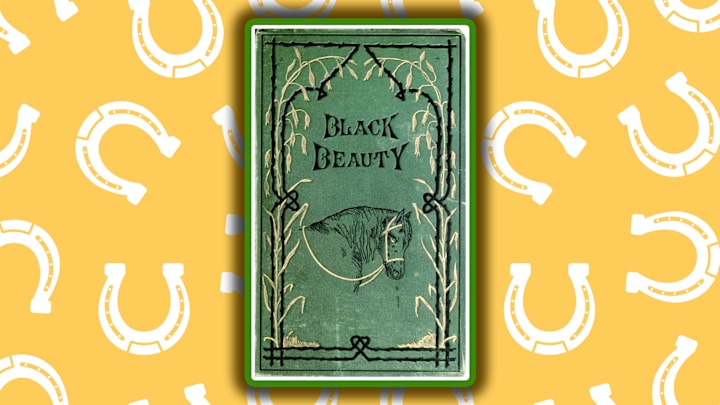Anna Sewell’s Black Beauty (1877)—or, to give it its full title, Black Beauty: His Grooms and Companions, the Autobiography of a Horse—is a classic piece of children’s literature. But although the writing style is certainly accessible for kids, Sewell actually wrote the novel with an adult audience in mind, hoping to influence people’s perceptions about animal welfare (or, rather, lack thereof).
Here’s how one author and a fictional horse managed to change the lives of countless real-life beasts of burden for the better.
Straight from the Horse’s Mouth
During the Victorian period—before the automotive industry took off—horses were seen and used as machines. In a 2012 NPR article, journalist Michele Norris explains that “horse power fueled almost everything: wars, agriculture, transportation, construction, and factory work.” The animals were necessary to keep daily life functioning, which often led to them being cruelly worked past their breaking points.
Sewell’s 1877 novel portrayed horses as living beings rather than as machines to be used and abused. Black Beauty is told from the POV of the titular ebony-colored horse; it’s even billed on the title page as being “Translated from the Original Equine by Anna Sewell.” It was a clever literary choice: Placing the reader in Black Beauty’s mind allows them to walk a mile in his horseshoes and witness the suffering he endures. “Black Beauty helped people see animals in a new way,” author Jane Smiley, who has written numerous horse-centric novels, told NPR. “As soon as you say that an animal has a point of view, then it’s very difficult to just go and be cruel to that animal.”

Cruelty is common in the novel. Although some people show Black Beauty kindness, others mistreat him. An aristocratic family makes him wear a then-stylish bearing rein (a.k.a. an overcheck or checkrein) when pulling their carriage, which forces him to hold his head unnaturally and painfully high. Later in the story, Black Beauty becomes a workhorse for a baker whose driver purposefully overloads the carts so he can make fewer trips.
Readers also learn about the poor treatment of the horses Black Beauty befriends. For instance, there’s Ginger, who was broken via beating, and Captain, who witnessed atrocities as a warhorse.
Champing at the Bit
Sewell’s appreciation for horses was partly born out of her own reliance on them. She injured her ankle when she was just 14, and when it failed to heal properly, she was left largely immobile and therefore reliant on horse-drawn carts to get around. Sewell grew particularly fond of her family’s horse, Bess, who likely provided the inspiration for Black Beauty years later.
But Sewell didn’t start penning Black Beauty until 1871, when she was 51 years old. In her journal, she wrote that the novel’s aim was “to induce kindness, sympathy, and an understanding treatment of horses.” This purpose is explicit within the novel itself, highlighted by lines such as “We call them dumb animals, and so they are, for they cannot tell us how they feel, but they do not suffer less because they have no words.”
Sewell also expressed her hope for the novel’s influence in a letter to her friend, Mary Bayly, who had sent her a quotation from Horace Bushnell’s now-out-of-print “Essay on Animals.” Sewell commented that Bushnell’s words “have followed me entirely through the writing of my book, and have, more than anything else, helped me to feel it was worth a great effort to try, at least, to bring the thoughts of men more in harmony with the purposes of God on this subject.”
A Real Gift Horse
Her book quickly became a hit, and it wasn’t long before the public’s perception about equine welfare began to shift. One million copies were distributed in the United States within a couple of years of its debut. Today, the book has sold more than 50 million copies worldwide.
Black Beauty was swiftly supported by animal rights activists, including brewery owner Edward Fordham Flower, who was outspoken about his opposition to the bearing rein, and George Angell, who circulated copies of the novel for the Massachusetts Society for the Prevention of Cruelty to Animals. Thousands of copies landed in the hands of people who worked with horses, from drivers to stable hands. In addition to hastening the decline of the bearing rein, the book also helped turn people off from unnecessarily cutting a horse’s tail really short for cosmetic purposes.

The novel prompted a fair share of philanthropic endeavors. It inspired a woman named Ann Lindo to found a charity in 1886—then called The Home of Rest for Horses, but renamed The Horse Trust in 2006—to provide respite for cab horses (and, these days, for all kinds of working equines in need).
Black Beauty continues to have an impact on animals even now, with sales of the book being used to raise money to help horses. In 2017, Redwings Horse Sanctuary—the UK’s largest equine charity—auctioned off a rare 1915 edition and used the funds to pay for food for rescued horses. In 2023, Redwings also collaborated with the UEA Publishing Project to create a special edition of Black Beauty, with 50 percent of the proceeds going to the charity.
Sewell unfortunately died just five months after Black Beauty’s publication, so she never got to see the massive impact her story had on the horses she hoped to help. But her literary legacy of advocating for animal welfare endures—Bernard Unti, the senior principal strategist in Communications for the Humane Society of the United States, even described Black Beauty as “the most influential anticruelty novel of all time.”
Read More About Horses:
